Purpose
Within the English Shepherd Breed, there exists a continuum of “black and tan” dogs, which includes those with the coat color as well as those for which the black and tan markings indicate a certain type. However, to effectively manage the breed and preserve its genetic diversity, it is crucial to prioritize the latter group – the ESBT dogs. Regardless of how they are labeled, preserving this group aligns with breed management theory and ensures the continued health and vitality of the breed. [1]Sponenberg, et. al., Managing Breeds for a Secure Future
The Argument
In this hypothetical argument, I aim to assert the existence of a continuum for Black and Tan English Shepherds. I will deduce that any dog can be either included or excluded from this continuum, and I will support this deduction with analyses of historical, phenotypic, and genotypic data as per breed classification theory (Sponenberg, op. cit.). To verify my claim, I will employ an 8-Point Classification Model to process the relevant data.

Claim
A Black and Tan English Shepherd continuum exists.
Inference
Any canine can be excluded from or included on the ESBT continuum.
Warrants
Investigations of history, phenotype and genotype are used to back the inference.
The primary warrant is based on Breed Classification Theory(Sponenberg op. cit.)
Evidence
Data processed through an 8-Point Classification Model.
Exposition
Background
The English Shepherd breed encompasses a continuum of black and tan canines. On one end of this spectrum, there are composite dogs that happen to have a black and tan coat with no indication of their type. These dogs are considered to have the “black and tan is just a coat color” attribute. On the other end, there are dogs whose pedigrees consist solely of black and tan ancestors. Between these two extremes are various permutations of the breed. It would be a continuum fallacy to claim that black and tan is solely a coat color of the English Shepherd breed, as there are multiple strains and identifiable ESBT bloodlines with unique histories and compositions. Unfortunately, some strains are no longer easily preserved, and others remain unmanaged without any documented history or advocacy. To support my claim of the existence of a Black and Tan English Shepherd Continuum, I will investigate history, phenotype, and genotype, as defined by breed classification theory (Sponenberg, op. cit.), and use an 8-Point Classification Model to test my hypothesis.
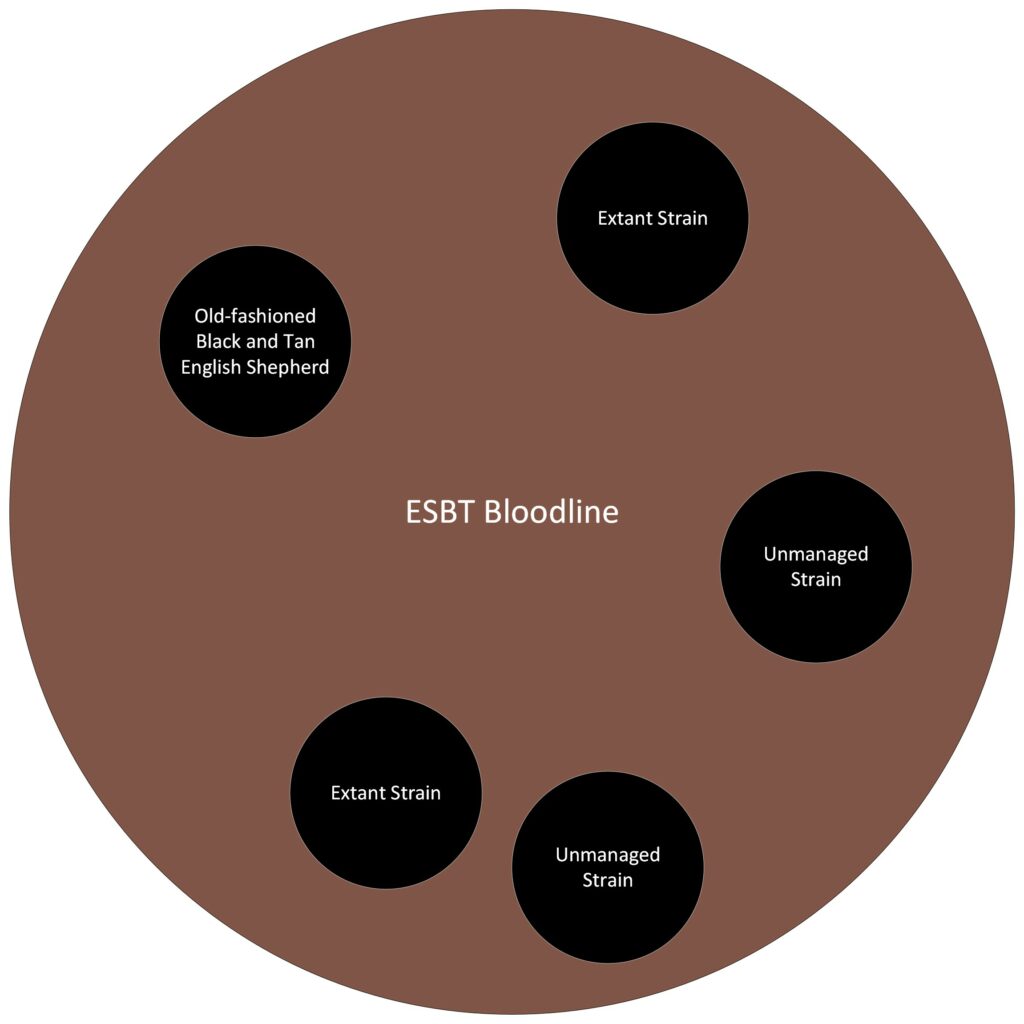
An Example of a Managed Strain
In recent times, a community-driven initiative has emerged to manage a particular strain of ESBT known as the Old-fashioned Black and Tan English Shepherd. This strain is deeply rooted in the culture and geography of its historical breeders and owners. The Blankenships’ dogs play a significant role as the foundation for this strain, and it has been nurtured by a group of breeders, including Janice Sallee, Mitchell Oney, Jim McGowan, James Maynard, and others. Over time, an anthropogenic history of the bloodline has been accumulated, and many of the genetic haplotypes of its members have been identified. The Blankenship Bloodline Standard has been used as a basis for its phenotype.
Justification
To support the claim of the Black and Tan Continuum, I will employ an 8 Point Classification Model. This model involves conducting a series of investigations that assign a value N to each aspect. The total sum of N values categorized as X determines the placement of a dog at point X on the continuum. Any dog with a score of zero is excluded from the continuum.
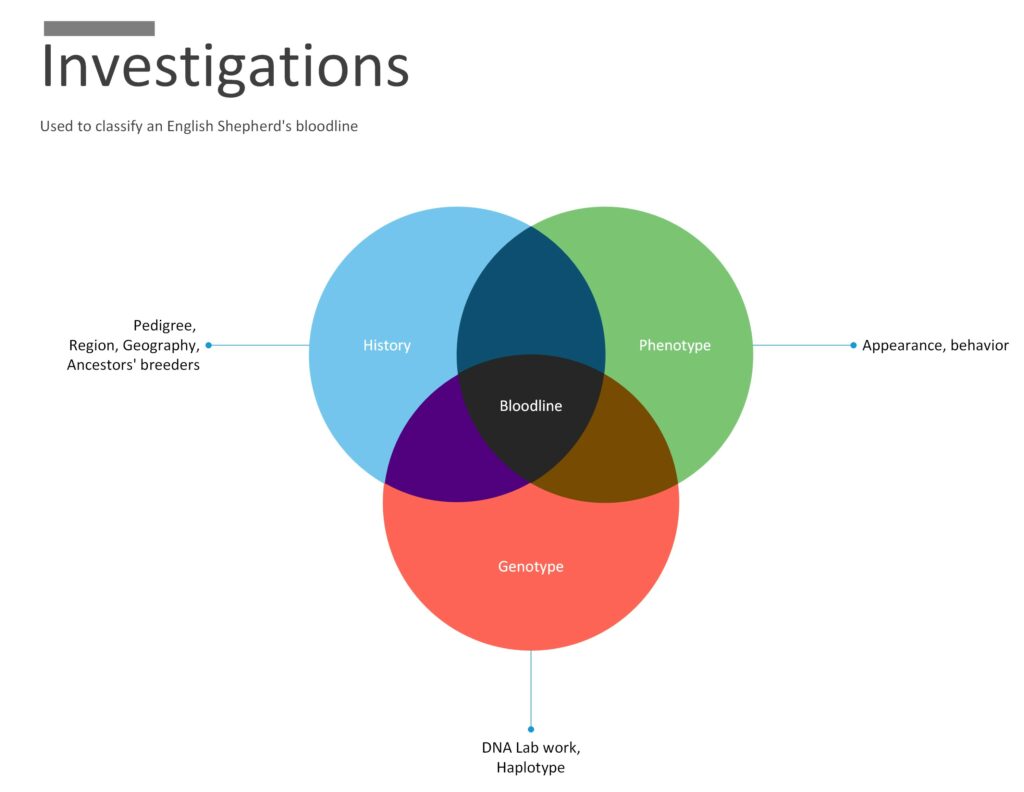
The 8-Point Classification Model utilizes specific variables to determine a dog’s placement on the Black and Tan Continuum, but it’s important to note that these variables do not affect the claim of the continuum’s existence nor exclude a dog from it. The two threshold variables, G and P, are set at 75% by default, which is considered to be a lenient setting compared to most literature that uses 87.5% as the composition threshold. However, adjusting these values does not compromise the validity of the claim. The haplotype arrays, MTA and PTA, also do not impact the premise, but they do influence the dog’s position on the continuum. These arrays are based on DNA lab results from a limited sample of dogs, which is a limitation but does not undermine the argument’s strength. This model is provisional, and as knowledge and evidence evolve, it allows for updates and revisions.
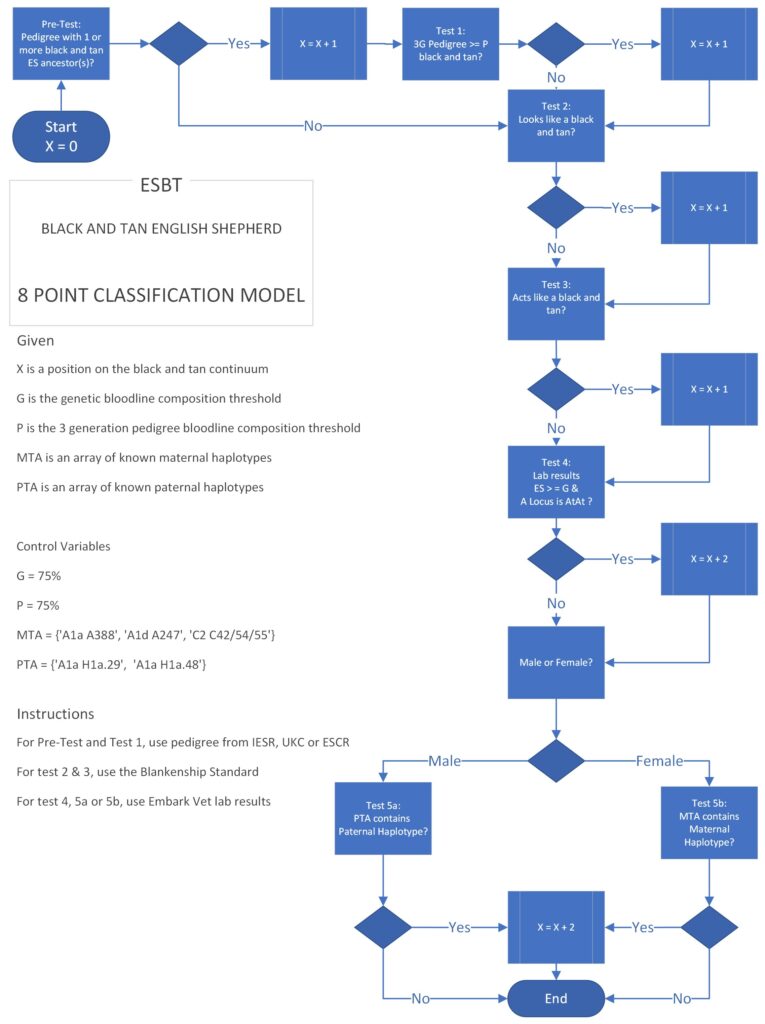
Testing the Genotype Investigations of the 8 Point Classification Model
The Genetic Data
Over a period of three years, the English Shepherd Embark Compare Tool was a web-based application that allowed English Shepherd owners to upload their dog’s Embark Vet lab work in CSV format and compare it to other English Shepherds. The data collection method remained consistent and continuous throughout the three-year period. The tool was advertised on Facebook and made accessible to all members of the English Shepherd breed community. The lab work of all 72 dogs submitted by community members was used for the test, and no dogs were excluded from the analysis.
Test Results Notation
To quantify test results, we’ll use an ESBT-X scale where X is a point on the continuum determined by using the logic and scoring of the classification model.
The Genotype Test Program
An open-source console application written in C# programming language was developed to analyze the genotype investigations (tests 4, 5a and 5b) of the 8-Point Classification Model. The program’s logic is publicly available in a source code repository on GitHub. To download or review the Embark CSV computer program, interested individuals can follow this link: https://github.com/tonybierman/embarkcsv. This program was used to analyze the lab data of the 72 dogs submitted by the English Shepherd community.
The logic of the 8-Point Classification Model scored 43 dogs at ESBT-0.
The logic of the 8-Point Classification Model scored 9 dogs at ESBT-2.
The logic of the 8-Point Classification Model scored 20 dogs at ESBT-4.
By using the logic of the 8-Point Classification Model, the computer program excluded ~60% of the dogs from the continuum. The program included ~40% of the dogs on the continuum, with ~12% of dogs at position 2 on the continuum and ~28% of dogs at position 4.
Below is a screenshot of the output from the program after it was run against the 72 dogs whose lab work was submitted by the English Shepherd community.
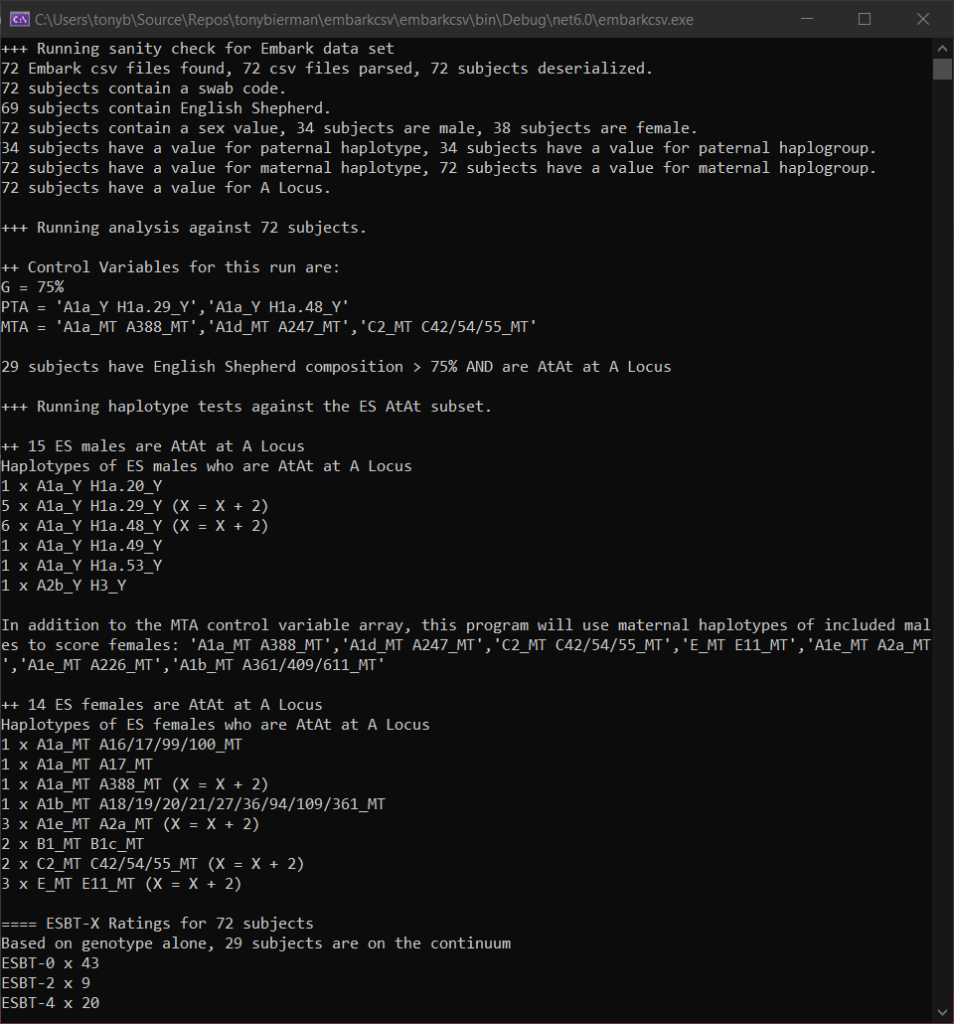
Conclusions of the Genotype Test
It’s important to clarify that while the genotype test program showed that an ESBT continuum exists and that any dog in the test data set could be excluded or included on the continuum using genotype investigations, the percentages mentioned (60%, 40%, 12%, 28%) refer specifically to the results of the test data set and cannot be generalized to the entire English Shepherd population. Additionally, while the results support the claim of a Black and Tan Continuum, they do not prove its existence definitively as the sample size may not be representative of the entire population.
Final Notes
The statement “Black and tan is just a coat color” is a continuum fallacy in the context of the English Shepherd breed. The existence of the ESBT bloodline has been documented for over 150 years, with repositories such as the IESR registry, ARF registry, and Judy Sutherland’s family’s stud books providing evidence. While it should have been evident that the ESBT bloodline exists, the culture and politics within the English Shepherd community required a more rational explanation.
An argument more nuanced than “black and tan is just a coat color” would acknowledge that while black and tan is indeed a coat color, it also signifies a particular type of dog. However, reducing the issue to a simple dichotomy oversimplifies the complexities involved. Therefore, treating black and tan as a continuum is beneficial to stakeholders, including advocates of the English Shepherd breed and the black and tan bloodline specifically. By doing so, we can better classify bloodline members, measure their composition, and manage breeding strategies with the goal of securing the bloodline’s future. In fact, managing strains within the ESBT bloodline can benefit the breed as a whole since preserving genetic diversity can be advantageous according to breed management theory (Sponenberg, op. cit).
References
| ↑1 | Sponenberg, et. al., Managing Breeds for a Secure Future |
|---|
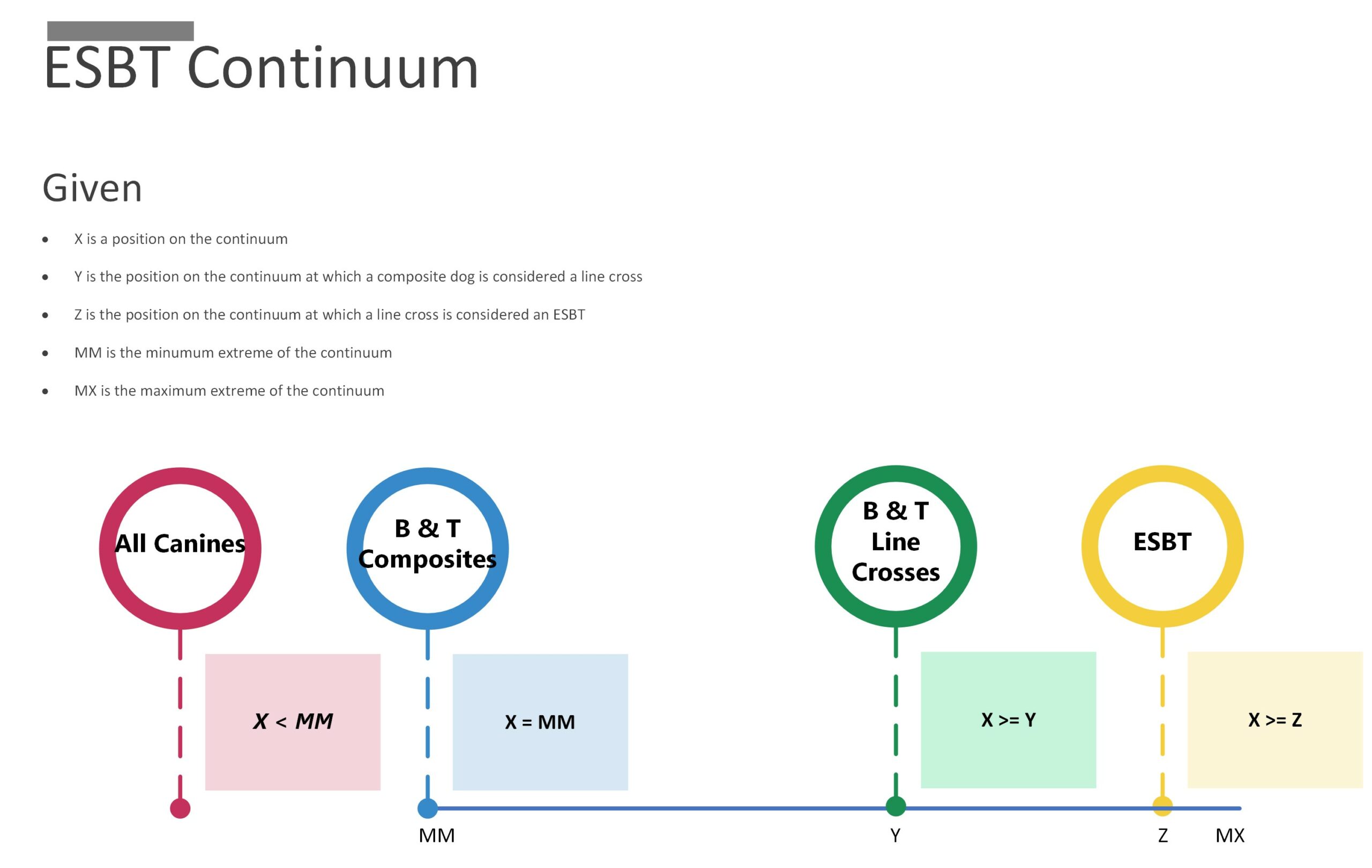

1 thought on “The Black and Tan English Shepherd Continuum – An Argument from Hypothesis”
Comments are closed.